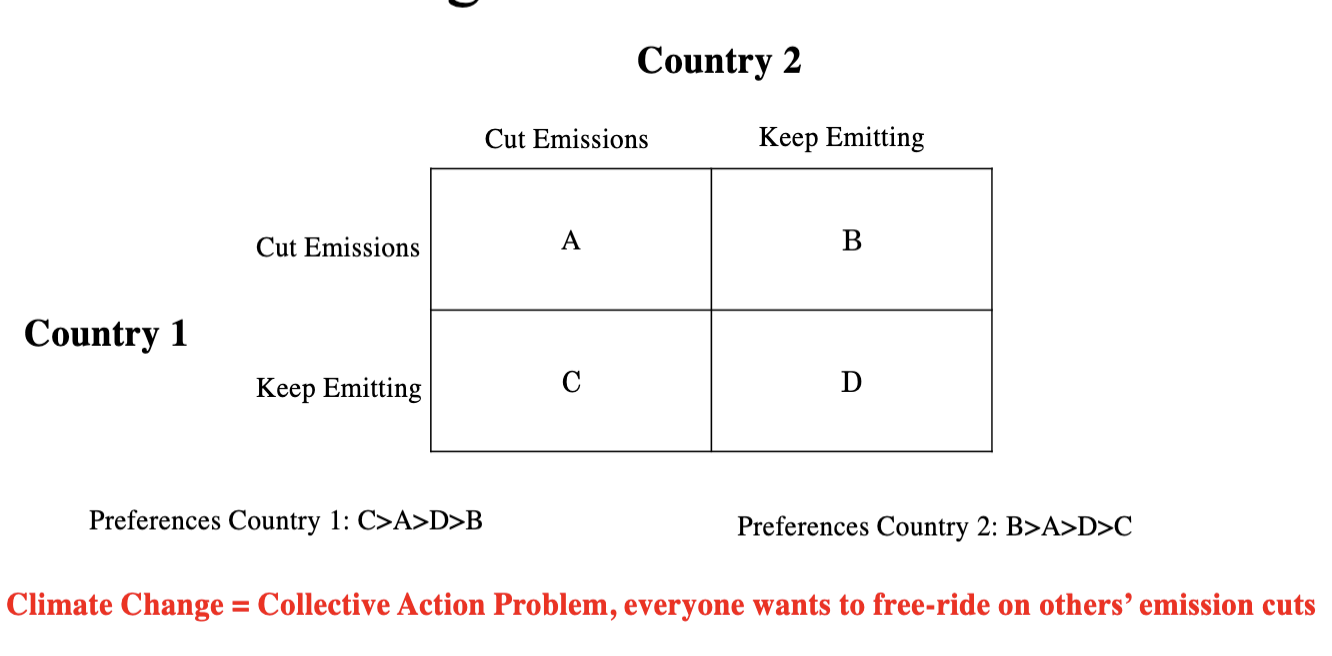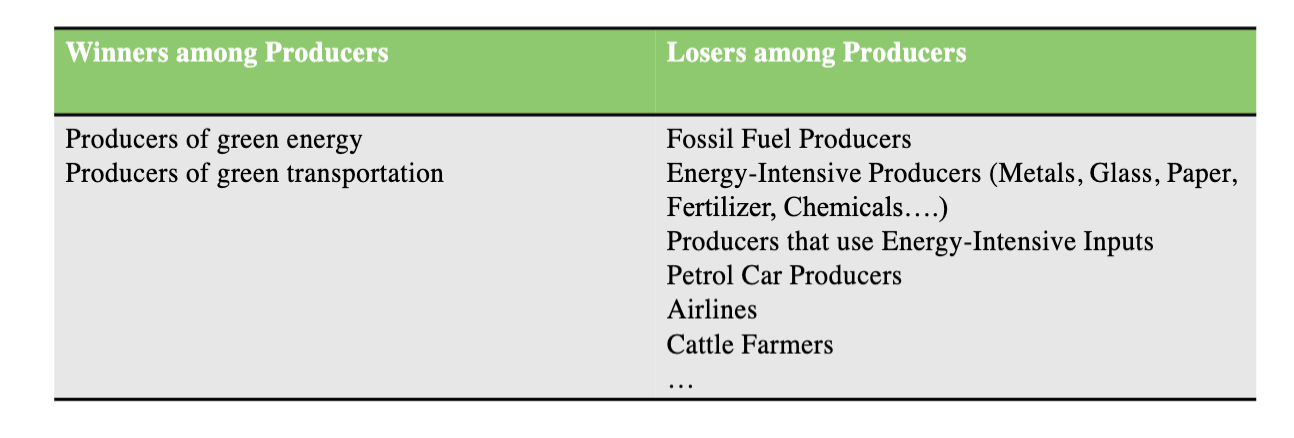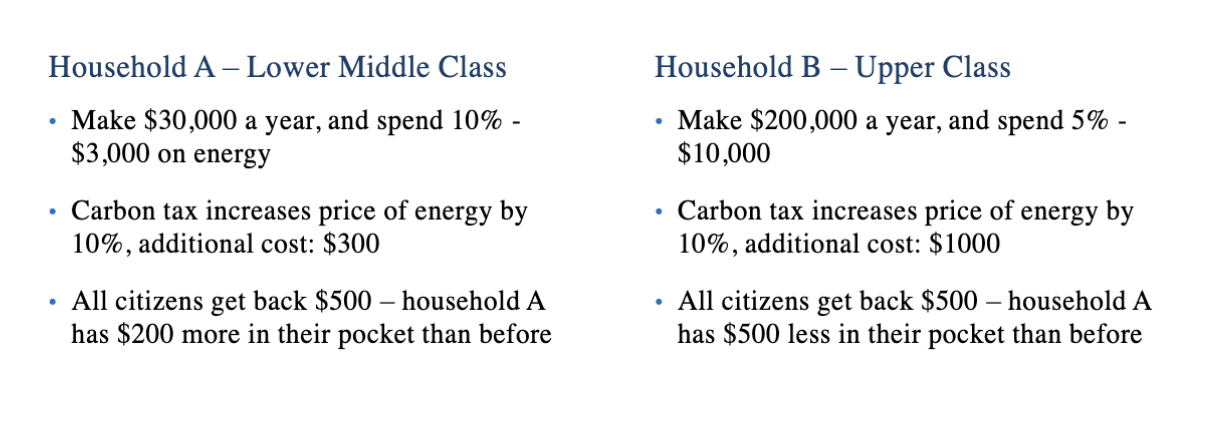lecture 12 Trade in Energy, OPEC and the IPE of Climate Change
1/35
There's no tags or description
Looks like no tags are added yet.
Name | Mastery | Learn | Test | Matching | Spaced |
|---|
No study sessions yet.
36 Terms
Two Interrelated Crises
russia’s invasion of ukraine
climate crisis
game plan
Game Plan
The Energy Trilemma
Oil Institutions: OPEC and the IEA
ClimateChange:
International Institutions
Domestic Interests and Institutions
3 Common EconomicClimatePolicies
The Energy Trilemma

its logically possible to achieve all three but its hard
Stable Energy Supply
Energy is a good that is more fundamental to our economies and lives than almost any other. We need it to:
Power production
Fuel most forms of transportation
Heat our homes
Supply Electricity to our homes
Abundance of reliable, cheap energy fuels economic development
allows more production
Lack of reliable, cheap energy can cause deep economic crises
Global Sources of Energy
mostly comes from fossil fuels
gas, oil, and coal = chunk of our energy
Global Trade in Energy
this energy is trade
huge flows of imports and exports
russia and middle east is a major supplier to europe
Institutions Governing Energy Policy
no overarching institutions like the WTO how to coordinate this trade in energy
•No ONE institution or agreement governing energy policy
Main Institution Oil Exporters: Organization of Petroleum Exporting Countries (OPEC)
Main Institution Oil Importers: International Energy Agency (IEA)
founded in response to OPEC
A lot of others related to energy:
UNFCCC (global climate change framework, more on that later)
IRENA (International RenewableEnergy Agency)
IAEA (International Atomic Energy Agency)
World Bank
increase lending for switch to green the economy
OPEC History
First half 20th Century: Oil production dominated by the “Seven Sisters”
Now: Exxon, Shell, BP, Chevron
1960: 5 countries (Saudi Arabia, Iraq, Iran, Kuwait, Venezuela) form OPEC to“ stabilize prices” and “ensure a fair return on capital for investors”
because before for exploitative
= trade union to negotiate with oil companies
more negotiation as a group rather then individuals
1970s: OPEC asserts power, oil embargo
From 1980s: Mandatory production quotas for members to keep supply steady and prices high
= OPEC becomes a “cartel”
small number of companies to try to manipulate the price on how they produce v how they charge
2016: OPEC+ (coordination with Russia and others)
coordinate with 10 other countries
OPEC Oil Embargo 1973
this started stagflation
By 1973: OPEC’s production of oil at over 50% world share
1973: Yom Kippur War
Arab members of OPEC impose an oil embargo on US & Netherlands and cut production
they refused to export oil
Result: Price of imported oil to US quadruples, double-digit inflation
high unemployement = bring monetarism and brings down keynesianism
Oil Cartel and Oil Prices
OPEC negotiates to curb production through quotas, keep prices high for everyone
•E.g. oil price drop after 2008 financial crash –OPEC countries jointly reduce output
BUT: coordinated output cuts hard to maintain –Prisoners’ Dilemma
everyone has a incentive to drill more oil and not cut
Some argue that Saudi Arabia –OPEC’s biggest producer –tries to uphold discipline through tit-for-tat
if you break the quota saudi arabia will break the quota
reciprocity
enforcing through multiple interactions
OPEC Today
13 member countries + 10 others with opec +
Still accounts for more than half of world’s crude oil
looks at opec when theres inflationary and energy crisis
Shale boom in US and Canada has undermined OPEC’s influence in North America
us produces alot by fracking
less on a influence on the US then it did in the 90s and 80s
The IEA: An Organization for Oil Consumers
Created 1974 under OECD framework (= only developed country members)
only members of the OECD
Goal: Reliable energy supply, avoid future oil shocks
Measures:
Emergency stocks & collective oil emergency response Promote energy efficiency and diversification
countries release oil stocks to try to counteract some of the price shocks that came with sactions (russia v ukraine)
Research into energy markets & consulting
(today) Promote Clean Energy Transition
Climate Change as Prisoners’ Dilemma

nash equilibrium: D
when no changes
Pareto optimality
Pareto optimality is the state at which resources in a given system are optimized in a way that one dimension cannot improve without a second worsening
colonialism and climate change
should we hold them rlly accountable if previously colonialized?
International Climate Negotiations
pre paris video
1992: countries agree on UNFCCC (United Nations Framework Convention on Climate Change)
Conference of the Parties (COP) held every 2 year
framework of yearly meetings
1)nations try to limit climate change to a extend that is manageable
2) we all have responsibility but differentiated by econ dev
COP 29 held in Baku this November
1997: Kyoto Protocol
Set limits for developed countries to make cuts
not for developing!!!!!!!!!!
US never ratifies, Canada pulls out
Emerging economies (China, India) grow rapidly but have no obligations under Kyoto
did the EU meet its obligations?
yes!!
A New Model: The Paris Agreement
More politically palatable:
Everyone has todo “something”
got rid of clear division where only developed had to cut
Countries themselves decide how much: Nationally Determined Contributions(NDCs)
but you can decide how ambitious you are
before hand kyoto had clear targets
Designed to allow US President to circumvent Congress
us refused to ratify the kyoto and prob would refuse under kyoto! So it means the pres can sign and doesn’t have to put it as a vote
(Some) Climate Finance
developed provides some money to the developing world
Core issues today:
Stock-take last year: How have countries done sofar? (result: not enough)
2.7 degrees warmer
Phasing out of fossil fuels
cop 28 was the first time actually mentioned fossil fuels
and transition out “phase out”
Climate finance, including“Loss and damage” fund
developing can draw on a fund when experiencing climate related disasters
Domestic Interests
Climate action requires that we restrict GHG-intensive activities through higher prices, bans, quotas..
In the long run, we all win from policies to mitigate climate change, but in the short-medium run:

cattel farms: land and water intensive
Domestic Collective Action Problems
The costs of effective climate action are acute and concentrated = easy for industry to organize and lobby
Domestic Collective Action Problems
The benefits of effective climate action are diffuse, they benefit everyone in the world = most (young) citizens benefit, but easy to free-ride off others’ climate protests
but not as much as lobbying on the industrial side
Domestic Collective Action Problems
Two outcomes that can arise from collective action problems:
1.Climate action is stopped/watered down due to force full lobbying
2.The costs of climate action are born by CONSUMERS, not BUSINESSES
1.E.g. The German Energy Transition largely paid for by energy taxes on households, not businesses
A Related Problem: Energy Poverty
When the price of GHG-intensive products rises, not all households can:
Pay to insulate their homes
Pay for an electric car
Install solar panels and heat pumps
Problem: The poorest households spend the biggest income share on energy
3 Common Policy Approaches
1.Carbon Taxes
2.Emission Trading
3.Green Industrial Policy
Carbon Taxes
Put a tax on carbon to “price in” the negative effect of climate change (Pigouvian tax)
What do you do with the tax revenue?
Pay for energy transition
Pay for adaptation, loss and damage of climate change
Use the money for something else
Canada and Switzerland: Rebates (Lump Sum = everyone gets the same back)
tax everyone take the money, take the total sum, and divide by tax payers and give the same amount of back to everyone.
still creates incentives, because your behavior does not affect your rebate
only the worst polluters worse off in the end
can be progressive –poorer households get back more
Problem: people tend to underestimate their rebates and overestimate the costs of carbon taxes
you don’t rlly look at how much you get back (rebates)
you look more at what you have to pay for taxes
= more unpopular

Carbon Taxes How are Lump Sum
Rebates Progressive?

poorer spend more on energy
poorer gets more money back on rebates
richer spend more —> less or non back
Emissions Trading: how do carbon markets work
cap and trade
more incentive for innovation and reduce emissions as fast as they can
more they cut —> fewer permits they need to buy
historically underpriced carbon —> less incentive to decarbonize
lots of permits—> started horting the permits, and lowered cap —> to make supply less = incentivize decarbonization
The world’s largest carbon market: European Emissions Trading System (ETS)
set up for the kyoto obligations
Globalized Trade = Carbon Leakage (?)
High price of carbon => companies shift production to countries with lower carbon prices
Evidence of existence of carbon leakage is mixed: so far, seems limited, but we don’t know what would happen at higher carbon prices
3 possible solutions to carbon leakage:
1.Global price on carbon (very, very hard to negotiate)
2.Tariffs on foreign goods at the border to “level the playing field”
3.Give free permits/tax breaks to companies that export/compete against energy-intensive imports
The EU Carbon Border Adjustment Mechanism
Initially, EU gave away free ETS permits to companies to “level the playing field” in import-competition and exports
Problem: Lots of free permits limit incentives to decarbonize•New solution: Instead of free permits for import competition, CBAM: tariff on products from countries that do not have equivalent carbon prices
Companies liked the idea of the CBAM AND free permits
Companies did not like the idea of paying for permits when CBAM introduced
instead of free ones
Note: This may incentivize countries that are dependent on EU market to also put a price on carbon
pos effect on other countries
why not free permits and tariffs?
WTO: What is Allowed?
You CAN impose trade measures to prevent climate change –exceptions for environmental protection in GATT Article XX
BUT those measures can’t be arbitrary or discriminatory:
YouCAN impose a CBAM
YouCAN put tariffs only on products from countries without carbon pricing
You CAN’T impose a CBAM and ALSO give your industry free permits
Sorry, European Industry, you can’t have it all
“Big Green Push”: Green Industrial Policy
Some argue that green industries should be treated as “infant industries”
Green transition requires large-scale investment in low-carbon technologies
Changes to public and private infrastructure:
charging networks for EVs,
pipelines for green hydrogen
smart grids in energy networks...
Green industrial policy has political benefits:
Instead of imposing costs on polluters, you give incentives and subsidies to green industries
Building up your green industries creates jobs
Green industrial policy fosters industries that will lobby in favor of climate action
US Inflation Reduction Act 2022
instead of taxing pollutions you give tax credits (subsidies) to those who invest in green energy (both companies and consumers)
Introduces Tax Incentives, Grants, Loan Guarantees
Tax credits (=subsidies) for companies investing in clean energy, transport and manufacturing
Tax credits for consumers to make EVs, solar panels, heat pumps etc. more affordable
WTO Rules and the US IRA
problem
only gives subsidies to those made in the USA
violates the national treatment principle
Many of the tax breaks are only applicable to locally produced goods (or goods produced by “trade partners)
E.g.consumers get a tax break for EVs produced in the US, but not in the EU
Limits of State Capacity
Definition State Capacity: “ability and effectiveness of a government or state in performing its functions and responsibilities, including policy-making, implementation, and service delivery, to meet the needs of its citizens” (Peters, 2018)
Green transitions require money and good governance:
Make and incentivize major investments
Monitor and enforce climate laws
Monitor the effective use of climate subsidies and climate aid
Build resilient infrastructure and disaster response
Many developing countries lack the state capacity to effectively implement a green transition
International Climate
Finance
“financing that seeks to support mitigation and adaptation actions that will address climate change”
Under UNFCCC, developed countries are supposed to provide and mobilize funds for developing countries’ climate action
In Paris, developed countries reaffirmed commitment to mobilize $100 billion per year until 2020
2022 exceeded $100 bn for first time ($118bn)
In Baku, they just agreed to increase that to $300 billion per year until 2030. Developing countries called this “a joke,” -trillions are needed
A New Supply Challenge: Raw Materials
Energy transition depends on critical raw materials used in batteries, low-carbon power generation and electricity grids
we will have to electrify alot of things
almost all are processed in china
china might leverage west dependence
Danger of disruptions –countries (and companies) have started to invest in lowering their dependence:
recycling, at-home processing, substitution
Watch out for global fights over raw materials: